Categories
Subjects
Authors
Artists
Venues
Locations
Calendar
Filter
Done
July 20, 2016 – Review
Sam Lewitt and Lucy Raven’s “Wild Sync & Weak Locals”
Isobel Harbison
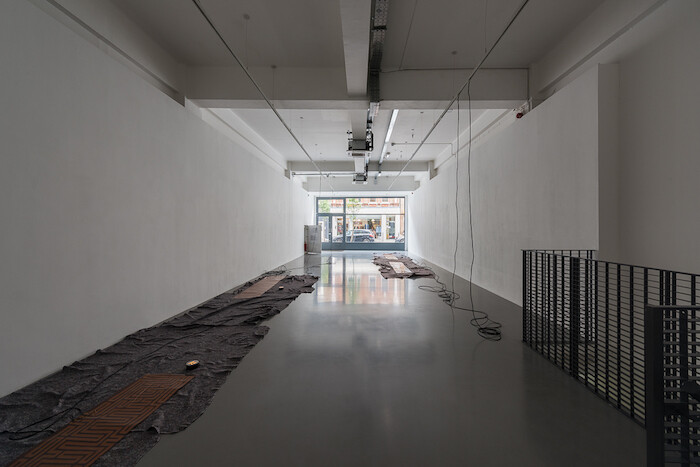
I walked straight past the entrance to Pilar Corrias’s gallery. The lights are off and inside it’s dark and quiet. The only work on the ground floor is Sam Lewitt’s A Weak Local Lexicon (MHTL) (2016), an unlit installation which converts the charge from the light source, powered from a distribution board in the wall, into heat emitted through four custom-made copper-plated panels lying on insulation blankets on the floor. Wires lead out from the mains in the wall to connect each panel, regulating the room’s moderately high temperature, altered slightly by my entrance. Little digital meters sit atop the panels, giving numeric readings of the oscillating flow. Their red blinking is the only visual noise of this otherwise ascetic piece.
The work began life among others in Lewitt’s solo exhibition “More Heat Than Light” at San Francisco’s CCA Wattis (2015) and Kunsthalle Basel (2016). Its copper patterning is custom designed to reflect the fretwork on the exterior of a Basel bank vault. This Ancient Greek motif, of a continuous line meandering towards infinity, symbolizes Lewitt’s long-term interest in technology’s deployment by capital, the process of circulation similar to that David Harvey describes in which “money is perpetually sent out in …
November 17, 2015 – Review
Ian Cheng’s “Emissary Forks at Perfection”
Matthew McLean
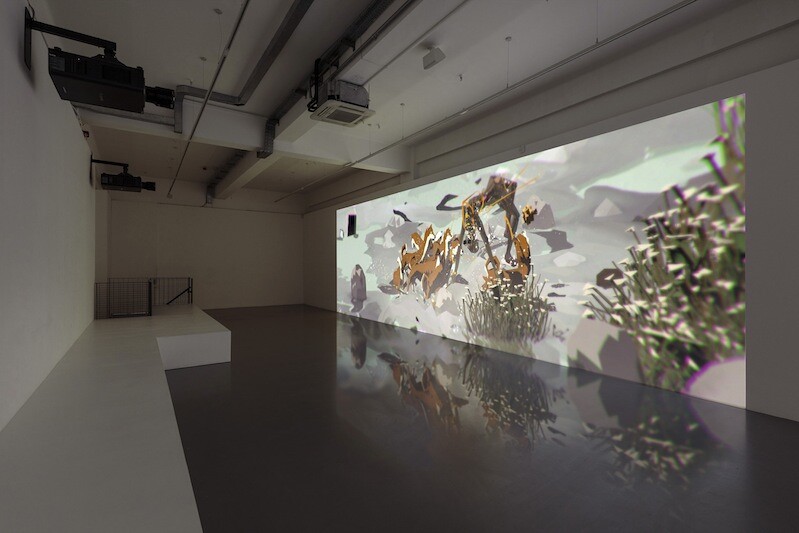
“How long do I need to stay,” I asked a staff member at Pilar Corrias of Ian Cheng’s Emissary Forks at Perfection (2015), “to watch the whole thing?” “It’s a live simulation,” they said of the title work of the artist’s first solo exhibition in London, “so it’s infinite.” Reconsidering, I asked how long I’d need to stay to get a grasp of what that meant. “About twenty minutes.”
Erring on the side of caution, I spent an hour and a half in the gallery. This “live simulation” comprises a ten-foot-wide projection onto the gallery’s wall, alone in the space except for a single flow chart. To the casual viewer it resembles a digital video, and I’m still unable to provide a useful technical definition of what a “live simulation” is. This much I heard and saw: a distorted girlish voice saying “Wake up!;” and a Shiba Inu—that Japanese dog breed of ancient pedigree and unearthly cuteness—named Emissary, summoned to guide a zombie through a depopulated, wild terrain.
Emissary’s face is first revealed to me among a sea of swaying angular white flowers like trapezoidal snowdrops, and virtually nothing in the landscape of the simulation is still. Every plant bends and quivers …
October 19, 2015 – Feature
London Roundup
Orit Gat
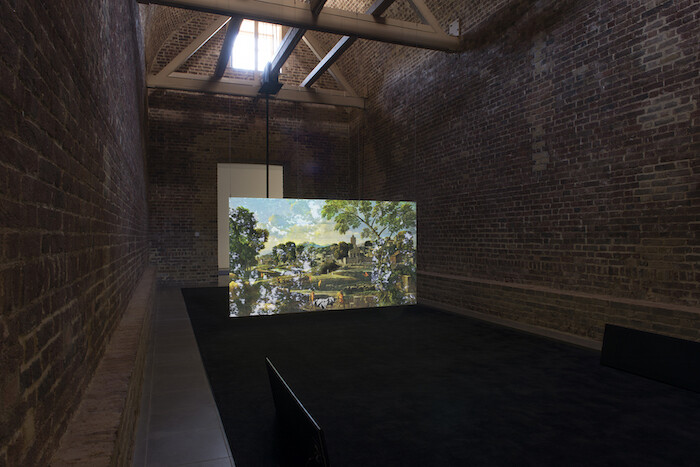
In an art fair week, when it seems like everyone around is constantly discussing where they were, what they saw, and how it was, discourse is dependent on physical participation, on the encounter with art in a space, strengthening the primacy of the exhibition as a mode of experiencing artwork. While there is still a lot of thinking to be made about how display has historically shaped production and continues to do so, Frieze week in London is a great moment to assess whether there is something about the exhibition that makes it such a lasting form.
So why do we still go see exhibitions? Chisenhale Gallery is showing Jumana Manna’s A magical substance flows into me (2015), a 70-minute film screened five times a day. It is an exploration of traditional local music in Palestine/Israel, based on Manna’s research into the work of the German-Jewish ethnomusicologist Robert Lachmann (1892-1939) in Mandatory Palestine. Manna plays radio recordings made by Lachmann on an iPhone to the participants in her film, ranging from a young Jewish musician singing the Arabic songs her Moroccan grandmother taught her to a Palestinian flute maker who explains that traditional Palestinian music is more fashionable in the West …
July 10, 2014 – Review
“Phantom Limbs”
JJ Charlesworth
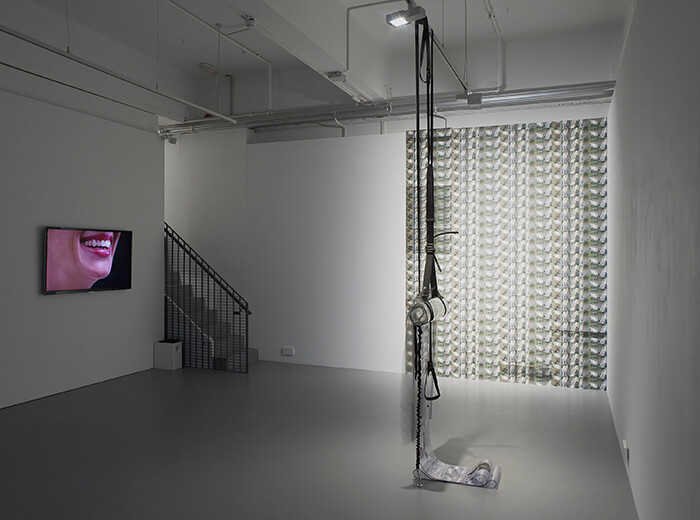
People who have lost arms or legs often report experiencing a “phantom limb”—the sense that the limb is still there, or that they can still move or feel it. It’s a good metaphor, too, for current post-internet art debates concerning the shifting relationship of real to virtual, digital to material. “Phantom Limbs,” Pilar Corrias’s smarter-than-most summer show, does a concise job of mapping the various poles of this cultural and theoretical inquiry. By assembling works that, broadly speaking, figure the human body as something caught in a world of networked relationships with images, technology, and other matter, the exhibition suggests that human subjectivity has in various ways been displaced or reconfigured—or maybe still implicated and entangled in the world, but no longer representing the Cartesian subject of an older, “anthropocentric” worldview.
If the footnoted gallery text is any indication, this exhibition wants to be taken seriously and plugs smoothly into current post-humanist critical trends. In addition to citing the written work of artist Hito Steyerl, the text makes grand pronouncements about the manner in which “notions of consciousness are evolving as a result of our digitally mediated experience.” It also asks leading questions like: “If we are able to feel […] …
January 16, 2013 – Review
John Skoog’s “Sent på Jorden and Förår”
Laura McLean-Ferris
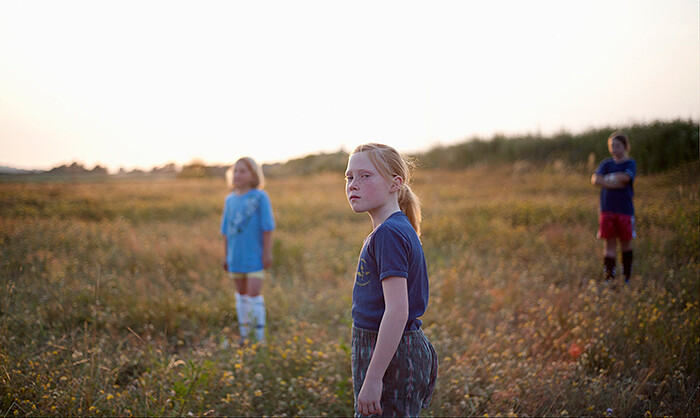
This darkened period following the new year, with only slim pickings of sunlight, is habitually described in the northern hemisphere by one succinct word: depressing. With the celebrations around the winter equinox to keep spirits up now over, people trudge glumly back to work, cheerless. Still, beyond existential gloom, this is a part of a natural cycle relating to our position on the planet, and we tend to accept it, along with all its rituals and associations. Dismal feelings, that is, are permitted.
John Skoog’s exhibition of two films at Pilar Corrias gallery in London transports viewers to two less depressing seasonal moments. The artist’s first film on show here, Sent på Jorden (2011), sends us hurtling to the days following the other equinox in midsummer. Its title translates as “late on Earth” and is taken from the surrealist work of the Swedish poet Gunnar Ekelöf. It is this sense of lateness, of impending gloom, which is powerfully conveyed in Skoog’s strung together series of short, speechless vignettes filmed in the artist’s birth place, the small rural Swedish town of Kvidinge (population 900). Each exquisitely constructed scene was filmed at dusk, with darkness continually threatening to close in, sending that unmistakable …
